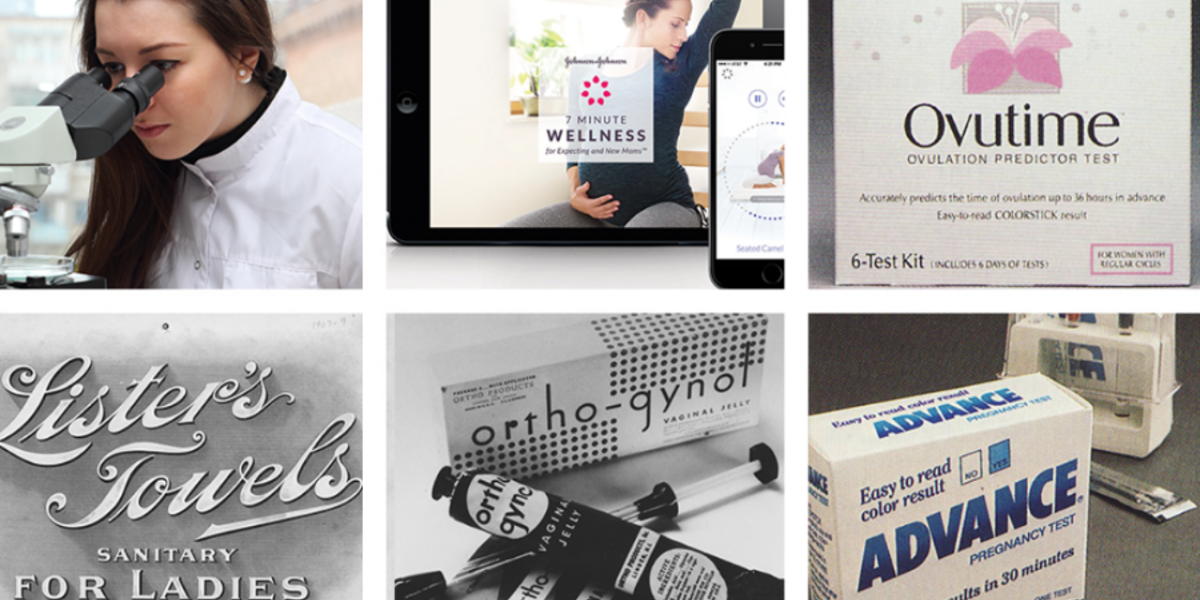.png)
11 Ways Johnson & Johnson Has Empowered Women Worldwide for Over 130 Years
As International Women’s Day encourages us to #PressforProgress, we take a look at how the company's innovations and initiatives have helped press for women's progress since its founding.
Since 1911, International Women's Day has been a moment to celebrate how far we've come in advancing women's rights—and a reminder of what we have yet to accomplish.
At Johnson & Johnson, supporting and igniting the power of women has been a top priority since its founding in 1886. When the company opened its doors, eight out of the first 14 employees were women, and by 1908, the company had eight female department supervisors—a rarity for that time, says Margaret Gurowitz, Chief Historian, Johnson & Johnson.
Today, the company continues to innovate with diversity and inclusion programs—helping it garner the #2 spot on the latest Thomson Reuters Diversity & Inclusion Index.
And this progressive approach doesn't just stay within company walls.
We take a look at the many ways Johnson & Johnson has empowered women all over the world with its pioneering innovations over the past 130 years.
1890s

Empowering Women ... During Childbirth
In the late 19th and early 20th centuries, expectant moms were responsible for gathering the clinical supplies needed for delivering at home, where most births took place.
To help reduce high rates of maternal and infant mortality during delivery, Johnson & Johnson teamed up with notable obstetricians to create Dr. Simpson’s Maternity Packet, a first-of-its-kind, mass-produced maternity kit designed to help prevent infections and ensure safe deliveries.
The kit—which was likely named after Dr. James Young Simpson, a pioneering Scottish obstetrician—contained such items as sterile sutures, an obstetric sheet and ligatures, antiseptic soap and flannel for wrapping the baby.
1897

Empowering Women ... By Selling the First Mass-Produced Sanitary Napkins
Before Johnson & Johnson began manufacturing Lister's Towels—the world’s first mass-produced, disposable, gauze-covered cotton pad—common forms of menstrual protection ranged from rags to rabbit skins—all of which provided poor protection and were dangerously unsanitary.
The idea was actually born from Johnson & Johnson's maternity kits. Dr. Joseph Brown Cooke, a surgeon at the New York Maternity Hospital in the late 1800s, worked with Johnson & Johnson to launch a comprehensive maternity kit packed with sanitary napkins—and women then encouraged the company to sell the pads separately.
1902

Empowering Women ... By Arming Them with Maternal Health Information
No doula coache
s, no What to Expect When You're Expecting, no pregnancy apps. At the turn of the 20th century, expectant moms didn't have a way to get trustworthy guidance on pregnancy and childbirth—until Johnson & Johnson debuted the Hygiene in Maternity manual.
The 4-by-6-inch manual, which was available at local drugstores, was designed to fit into a woman's pocket or purse. Its pages featured advice on everything from how to calculate a delivery date to how to prepare for labor, says Gurowitz. The book was also surprisingly modern for its time: It offered advice on keeping Mom healthy during pregnancy, including encouraging moderate exercise.
1904

Empowering Women ... By Inventing Disposable Diapers
By 1900, women were beginning to enter the workforce in greater numbers—a trend that would continue throughout the 20th century due to shifting gender roles and the need for a larger labor force during World Wars I and II.
To help the growing number of hardworking mothers who didn’t have time to scrub tough-to-clean cloth diapers, Johnson & Johnson invented the world’s first disposable variety, Lister’s Sanitary Diapers, which were made from several layers of absorbent cotton, cellulose sheets and gauze.
Named after Sir Joseph Lister, who pioneered sterile surgery, the diapers were sterilized to help ward off disease at a time when 100 out of every 1,000 infants didn't make it to their first birthday.
1931

Empowering Women ... By Pioneering Family Planning
Just two years after the legendary stock market crash of 1929 and while a devastating drought was sweeping through the Great Plains, Johnson & Johnson introduced Ortho-Gynol®, the first prescription contraceptive gel in the world designed to help women take charge of family planning.
"Before the advent of hormonal birth control, women seeking contraception had to rely on cervical caps and condoms," explains Gurowitz. "So the introduction of Ortho-Gynol was a huge leap forward."
1971

Empowering Women ... By Inventing (Finally!) Comfortable Period Protection
By 1971, thanks to a wave of feminism that was pushing for equal treatment in athletics (Title IX would pass in 1972), more women were turning to exercise—but traditional sanitary protection couldn’t keep up.
Always one step ahead of the times, Johnson & Johnson introduced yet another cutting-edge feminine hygiene product in Stayfree® Mini and Maxi Pads, which were some of the first sanitary products that didn’t require belts, hooks or special garments. The pads featured an adhesive strip that kept them in place in standard underwear and offered less-bulky protection that could stand up to a lot more movement.
1984

Empowering Women ... By Creating a Faster, More Accurate Pregnancy Test
When at-home pregnancy tests first arrived on the market in the 1970s, women had to wait up to two stressful hours for the results. That is, until 1984, when Johnson & Johnson debuted the Advance Home Pregnancy Test, which was 99% accurate—and cut the wait time to just 30 minutes.
Best of all, women knew, without question, if they were pregnant because the test's first-of-its-kind Colorstick technology turned unmistakably blue for positive results.
1985

Empowering Women ... By Inventing an At-Home Ovulation Test
While birth control had become legally available to all U.S. women following the 1972 Eisenstadt v. Baird Supreme Court case ruling, the science behind ovulation and conception lagged behind and women had to rely on monitoring their physical signs and symptoms.
In 1985, women finally had a more scientific option when Johnson & Johnson's Ortho Pharmaceutical Corporation released the Ovutime Ovulation Test, which included six days of tests that could predict ovulation up to 36 hours in advance.
The kit was available over the counter, allowing women to test for ovulation in the privacy of their own homes rather than having to visit their doctor.
It helped with family planning and was a vital tool at a time when educational campaigns were stressing the importance of getting enough folic acid in early pregnancy and warning of the risks of alcohol consumption.
2010

Empowering Women ... Through the Power of Digital Technology
Since 2010, Johnson & Johnson has helped give expectant women living in underserved communities access to vital health information about pregnancy, labor and infant care through such mobile messaging programs as mMitra in India and MomConnect in South Africa.
mMitra targets low-income women in urban Indian communities, where rates of death from pregnancy complications and early childhood disease are high. Through mMitra, women receive voice calls twice a week, in their chosen language, that provide preventative care information tailored to their stage of pregnancy or the developmental stage of their child. To date, the program has reached more than 1 million mothers in India.
MomConnect, which is available via SMS or WhatsApp, is a stage-based, twice-weekly text-messaging service for new and expectant moms that also enables them to text back with questions or feedback on the quality of care they've received. More than 1.8 million women have received MomConnect messages, and the program has expanded to nurses and midwives, too.
2016

Empowering Women ... To Take Care of Themselves, Too
Whether you're pregnant or up in the wee hours of the morning tackling newborn feeding, it goes without saying that motherhood can be both a joyous and stressful time in life. To help women with these challenging moments, Johnson & Johnson unveiled the 7 Minute Wellness for Expecting and New Moms™ App, a science-based wellness resource created by the company's behavioral, exercise and medical experts.
The app helps moms manage and expand their energy levels through guided meditation sessions and quick, easy exercises—empowering them to be their best selves both mentally and physically.
2016-2017

Empowering Women ... To Succeed in STEM
In 2016, Johnson & Johnson launched 10 worldwide partnerships to help drive the number of undergraduate women enrolling in and declaring majors in the fields of science, technology, engineering, math, manufacturing and design, which it dubbed WiSTEM2D.
"When women and girls fall off these career tracks, we are all robbed of potential innovators and leaders," says Meri Stevens, Vice President, Strategy & Deployment, Johnson & Johnson Supply Chain. "At Johnson & Johnson, we are taking concrete steps to help girls of all ages stay on the STEM track."
These partnerships are part of a companywide commitment to harnessing the power of diversity to improve health for humanity. Partnerships like one with FHI 360 and Junior Achievement, which provides out-of-school STEM programs for girls between the ages of 5 and 18.
On the heels of WiSTEM2D, Johnson & Johnson also introduced the Women in STEM2D Scholars Program in 2017, which helps support up-and-coming women working in these fields by providing monetary awards and mentorship at that critical time in their research careers between completing an advanced degree and becoming tenured at a university or institution.
The original article was published here.
Blogs for you
Half the Sky's mission is to supply the tools that can give every woman the ability to build a successful career and be fully prepared for the future of work. So, that they can lead a healthy, prosperous and more balanced/blended lifestyle of their choosing. By building your confidence, you’re setting foundations to empower yourself and your career. The world is your oyster, and it starts with you.
Enjoyed this article let us know your thoughts in the comments below:
About half the sky
half the sky (HTS) is a career platform for women connecting you to career opportunities at companies that care. Providing you with information, tips and strategies to navigate the rapidly changing workplace.
Sign up to get career tips and job alerts directly to your inbox! Join us to shape the future of women at work together!



